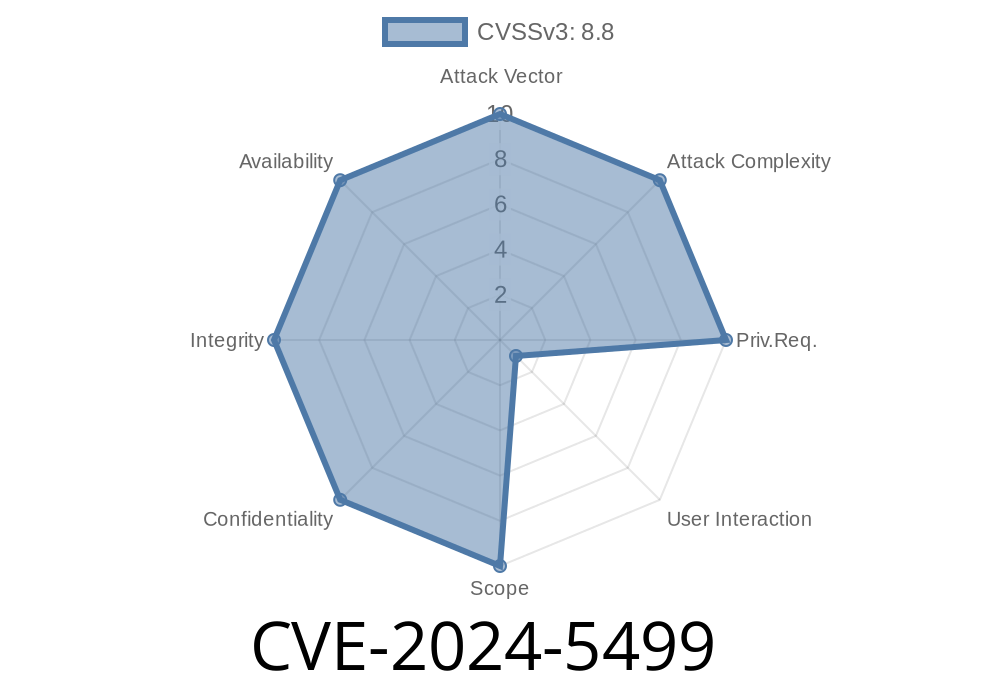By exploiting an out-of-bounds write vulnerability in the Streams API of Google Chrome browsers, a remote attacker can easily execute arbitrary code inside a sandbox. This exploit has the potential to cause significant harm, given that Google Chrome is one of the most popular browsers worldwide. The issue affects Google Chrome versions prior to 125..6422.141. Google has addressed this security risk and classified it as a high-severity issue in Chromium.
In this long-read post, we'll delve deep into the exploit details, explaining the vulnerability and furnishing readers with code snippets as well as links to the original references. Additionally, we'll share steps to mitigate the risks associated with the CVE-2024-5499 vulnerability.
Vulnerability Details
The identified vulnerability (CVE-2024-5499) is caused by an out-of-bounds write in the implementation of the Streams API in Google Chrome. The issue arises when a remote attacker crafts a malicious HTML page, which triggers an out-of-bounds write in the browser. Consequently, this allows the attacker to execute arbitrary code within the sandboxed environment of Google Chrome.
Here's a snippet showcasing an example of the vulnerable code within the Streams API
function triggerVulnerability() {
let readableStream = new ReadableStream();
let writableStream = new WritableStream();
readableStream.pipeTo(writableStream).catch((error) => {
// Handle error.
});
// Crafted manipulation that triggers the vulnerability.
}
This vulnerability allows the attacker to gain initial foothold within the victim's system or network, paving the way for escalation to more severe attacks, such as remotely controlling the computer, stealing sensitive data, or even spreading malware.
Original references related to the vulnerability can be found in the following links
* Google Chrome Official Blog Post
* CVE-2024-5499 - National Vulnerability Database
* Chromium Bug Report
Exploit Details
The exploit for CVE-2024-5499 is typically delivered via spear-phishing emails or malicious advertisements loaded on legitimate websites. The attacker entices the victim to click on a link that leads to a crafted HTML page, designed to exploit the vulnerability.
The following code snippet demonstrates the exploitation process, which leverages the vulnerability to execute arbitrary code within the affected Google Chrome browser:
function performExploit() {
let maliciousCode = /* ... */; // The malicious code to execute within the sandbox.
let exploit = triggerVulnerability();
exploit(maliciousCode).then((result) => {
// Exploit execution successful.
}).catch((error) => {
// Exploit execution failed.
});
}
Upon successful code execution, the attacker can gain initial access, steal sensitive information or even download further malware onto the victim's device, depending on the nature and intent of the malicious code.
To safeguard against the CVE-2024-5499 vulnerability, follow these steps
1. Update Google Chrome: Ensure that you're using the latest version of Google Chrome (version 125..6422.141 or later). You can check for updates by navigating to "chrome://settings/help" within your Chrome browser.
2. Enable Site Isolation: Enabling Site Isolation provides an extra layer of security, as it separates each website and extension into its process. To enable this feature, navigate to "chrome://flags/#enable-site-per-process" and change the setting to "Enabled," before relaunching your browser.
3. Stay cautious online: Avoid clicking on suspicious links, especially those in untrusted emails or sketchy websites. Always verify the legitimacy of the source and ensure that your browser is up-to-date to minimize risks associated with vulnerabilities like CVE-2024-5499.
Conclusion
CVE-2024-5499 is a crucial vulnerability affecting millions of users worldwide through the highly popular Google Chrome browser. By understanding the vulnerability and its exploit details, you can better protect yourself against potential remote code execution attacks. Keeping your browser up-to-date and following best practices for online safety are critical measures to secure yourself from exploits like CVE-2024-5499.
Timeline
Published on: 05/30/2024 23:15:48 UTC
Last modified on: 07/03/2024 02:09:01 UTC
